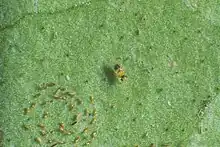| Encarsia | |
|---|---|
 | |
| Adult Encarsia perplexa with eggs and hatching nymphs of citrus blackfly | |
| Scientific classification | |
| Domain: | Eukaryota |
| Kingdom: | Animalia |
| Phylum: | Arthropoda |
| Class: | Insecta |
| Order: | Hymenoptera |
| Family: | Aphelinidae |
| Subfamily: | Coccophaginae |
| Genus: | Encarsia Foerster, 1878 |
| Species | |
|
See text | |
Encarsia is a large genus of minute parasitic wasps of the family Aphelinidae. The genus is very diverse with currently about 400 described species and worldwide distribution.[1] The number of existing species is expected to be several times higher because many species are still undescribed.[2] Encarsia is a very complex genus, with specimens showing both inter- and intra-specific variations, making morphological classification difficult.[3]
The adult wasps, tiny insects about 1 or 2 millimeters in size, are primarily parasitoids of sessile stages of Sternorrhyncha, in particular whiteflies (Aleyrodidae) and scale insects (Diaspididae). A few species are known to parasitize aphids, eggs of shield-back bugs (Plataspidae), and eggs of Lepidoptera. Females mostly develop as primary endoparasitoids, and males are commonly hyperparasitoids of the same or other species. This so-called heteronomy, a sexually dimorphic host relationship, occurs in quite a few species.[4][5]
Species of Encarsia are of particular interest because of their economic importance for biological pest control, especially in horticulture and for crops grown under glass. Many seem to be extremely host-specific which is an important trait for an acceptable and effective bio-control agent.
Species used in biological control
- Encarsia berlesei on white peach scale (Pseudaulacaspis pentagona)[6]
- Encarsia bimaculata on sweet potato whitefly (Bemisia tabaci)[7]
- Encarsia clypealis on citrus blackfly (Aleurocanthus woglumi)[8]
- Encarsia formosa on greenhouse whitefly (Trialeurodes vaporariorum)[9]
- Encarsia harrisoni on long mussel scale (Lepidosaphes gloverii)[6]
- Encarsia inaron on cabbage whitefly (Aleyrodes proletella)[10] and ash whitefly (Siphoninus phillyreae)[11]
- Encarsia lahorensis on citrus whitefly (Dialeurodes citri)[6]
- Encarsia lutea on silverleaf whitefly (Bemisia tabaci/Bemisia argentifolii) and greenhouse whitefly (Trialeurodes vaporariorum)[12]
- Encarsia pergandiella on sweet potato whitefly (Bemisia tabaci)[13]
- Encarsia perniciosi on San Jose scale (Quadraspidiotus perniciosus) [6]
- Encarsia perplexa (syn. Encarsia opulenta) on citrus blackfly (Aleurocanthus woglumi)[14]
- Encarsia sophia on papaya whitefly (Trialeurodes variabilis) and sweet potato whitefly (Bemisia tabaci)[15]
- Encarsia tricolor on cabbage whitefly (Aleyrodes proletella)[10]
References
- ↑ Noyes, J. S. 2003. Universal Chalcidoidea database
- ↑ Heraty, J. M., et al. (2008) Systematics and Biology of Encarsia. Chapter 4, pp. 71-87 In: Gould, J., et al. (Eds), In: Classical Biological Control of Bemisia tabaci in the United States. A review of interagency research and implementation. Progress in Biological Control 4. Springer Science and Business Media B. V. 1-343.
- ↑ Hayat, Mohammad (1989). "A revision of the species of Encarsia Foerster (Hymenoptera: Aphelinidae) from India and adjacent countries" (PDF). Oriental Insects. 23: 1–131. doi:10.1080/00305316.1989.11835501. Archived (PDF) from the original on 31 December 2013.
- ↑ Williams, T. and A. Polaszek. (1996). A re-examination of host relations in the Aphelinidae (Hymenoptera: Chalcidoidea). Biological Journal of the Linnean Society 57: 35-45. doi:10.1111/j.1095-8312.1996.tb01694.x
- ↑ Hunter, M. S. and J. B. Woolley. (2001). Evolution and behavioral ecology of heteronomous aphelinid parasitoids. Annual Review of Entomology 46, 251-90.
- 1 2 3 4 "EPPO". Archived from the original on 2011-07-19. Retrieved 2010-12-19.
- ↑ Heraty, J. M., et al. (2008). Systematics and Biology of Encarsia. Chapter 4, pp. 71-87 In: Gould, J., et al. (Eds), In: Classical Biological Control of Bemisia tabaci in the United States. A review of interagency research and implementation. Progress in Biological Control 4. Springer Science and Business Media B. V. 1-343.
- ↑ Singh, S. P. (2004) Some success stories in classical biological control of pests in India. Asia-Pacific Association of Agricultural Research Institutions, Publication 2004/2.
- ↑ Hoddle, M. S., et al. (1998). Biology and use of the whitefly parasitoid Encarsia formosa. Annual Review of Entomology 43, 645-69.
- 1 2 Williams, Trevor (1996). "Invasion and displacement of experimental populations of a conventional parasitoid by a heteronomous hyperparasitoid" (PDF). Biocontrol Science and Technology. 6 (4): 603–618. doi:10.1080/09583159631244. Archived (PDF) from the original on 31 December 2013.
- ↑ Ash Whitefly. Center for Invasive Species Research. University of California, Riverside. 2009.
- ↑ Schauff, Michael E.; Evans, Gregory A. (1996). "A pictorial guide to the species of Encarsia (Hymenoptera: Aphelinidae) parasitic on whiteflies (Homoptera: Aleyrodidae) in North America" (PDF). Proceedings of the Entomological Society of Washington. 98: 1–35. Archived from the original (PDF) on 31 October 2004. Retrieved 31 December 2013.
- ↑ Hoelmer, K. and J. Goolsby. Release, establishment and monitoring of Bemisia tabaci natural enemies in the United States. In: 1st International Symposium on Biological Control of Arthropods, Honolulu, Hawaii, January 2002. pp. 58-65.
- ↑ Nguyen, R., et al. (1983). Population density of the citrus blackfly, Aleurocanthus woglumi Ashby (Homoptera: Aleyrodidae), and its parasites in urban Florida in 1979-1981. Environmental Entomology 12, 878-84.
- ↑ Luo, C. and T. X. Liu. (2011). Fitness of Encarsia sophia (Hymenoptera: Aphelinidae) parasitizing Trialeurodes vaporariorum and Bemisia tabaci (Hemiptera: Aleyrodidae). Insect Science 18(1), 84-91.